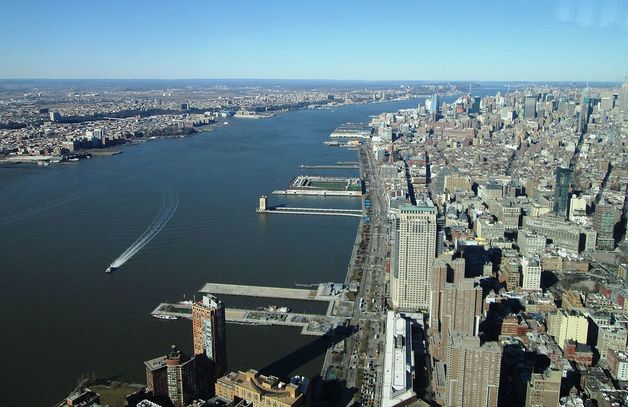|
Who looks upon a river in a meditative hour, and is not reminded of the flux of all things? — Emerson, Nature The Mohicans called it Muhheakunnuk, “the river that flows two ways", recognizing the Hudson as not only a river but a tidal estuary, where south-flowing fresh water collides with saline sea water pushing north twice a day, like a giant, slow-motion exhale. With a recent post focusing on waterways and cities, let’s take a moment to appreciate the magnificent river flanking New York City’s west side, a river that attracted native inhabitants; beckoned explorers, from Verrazano to Hudson (in search of a waterway to China); helped a new nation grow and achieve global influence; inspired a school of art influenced by Romanticism; and even has a museum dedicated to it (in Yonkers). Its headwaters in the Adirondacks at an altitude of over 4,300 feet, the Hudson begins as a series of alpine brooks and ponds – Lake Tear of the Clouds, to Feldspar Brook, to Opalescent River, and then Calamity Pass Brook and Indian Pass Brook to Henderson Lake, where a convergence of rivers become “The Hudson”. Winding its way south to Troy, the northern reach of tidal influence, it widens and continues on its 315 mile route. Reaching its widest point of 3 ½ miles in Haverstraw, it continues past Manhattan, and flows beneath the Verrazano Bridge, through the Narrows between Brooklyn and Staten Island and into the Atlantic Ocean. But it doesn’t end there. At the mouth of the Hudson River begins the Hudson Canyon, a submarine canyon extending over 400 miles into the Atlantic, cutting through shallower continental shelf and then dramatically into the deeper ocean basin. With walls reaching ¾ mile from the ocean floor at its deepest point, 100 miles off shore, it rivals the depth of the Grand Canyon’s mile-deep cliffs and is one of the largest submarine canyons in the world. Last exposed over 10,000 years ago, during the last ice age, the canyon formed when the sea level was 400 feet lower and the mouth of the Hudson was 100 miles east of its current site. If you can, take a look at the river. You might notice it flowing north! You also may notice a patchwork of movement across its surface – central sections dredged deeper for shipping perhaps moving more swiftly than shallower areas along Manhattan and New Jersey, various micro-currents, and the influence of wind. Think about the clash of forces and wave patterns when the tide is moving in, pushing against the current. And think about how quickly the river moves when the tide is outbound, a double whammy of south-bound current and outbound tide conspiring. Think about traces of the Hudson continuing off shore, through one of the world's deepest submarine canyons, and about the ebb and flow of the river that flows two ways. Suddenly Poughkeepsie Grace Paley, 2007 what a hard time the Hudson River has had trying to get to the sea it seemed easy enough to rise out of Tear of the Cloud and tumble and run in little skips and jumps draining a swamp here and there acquiring streams and other smaller rivers with similar longings for the wide imagined water suddenly there’s Poughkeepsie except for its spelling an ordinary town but the great heaving ocean sixty miles away is determined to reach that town every day and twice a day in fact drowning the Hudson River in salt and mud it is the moon’s tidal power over all the waters of this earth at war with gravity the Hudson perseveres moving down down dignified slower look it has become our Lordly Hudson hardly flowing and we are now in a poem by the poet Paul Goodman be quiet heart home home then the sea
0 Comments
Leave a Reply. |
About this Blog
Hi! I'm Nancy Kopans, founder of Urban Edge Forest Therapy. Join me on an adventure to discover creative ways to connect with nature in your daily life, ways that are inspired by urban surroundings that can reveal unexpected beauty, with the potential to ignite a sense of wonder. Archives
April 2023
Categories
All
|


 RSS Feed
RSS Feed